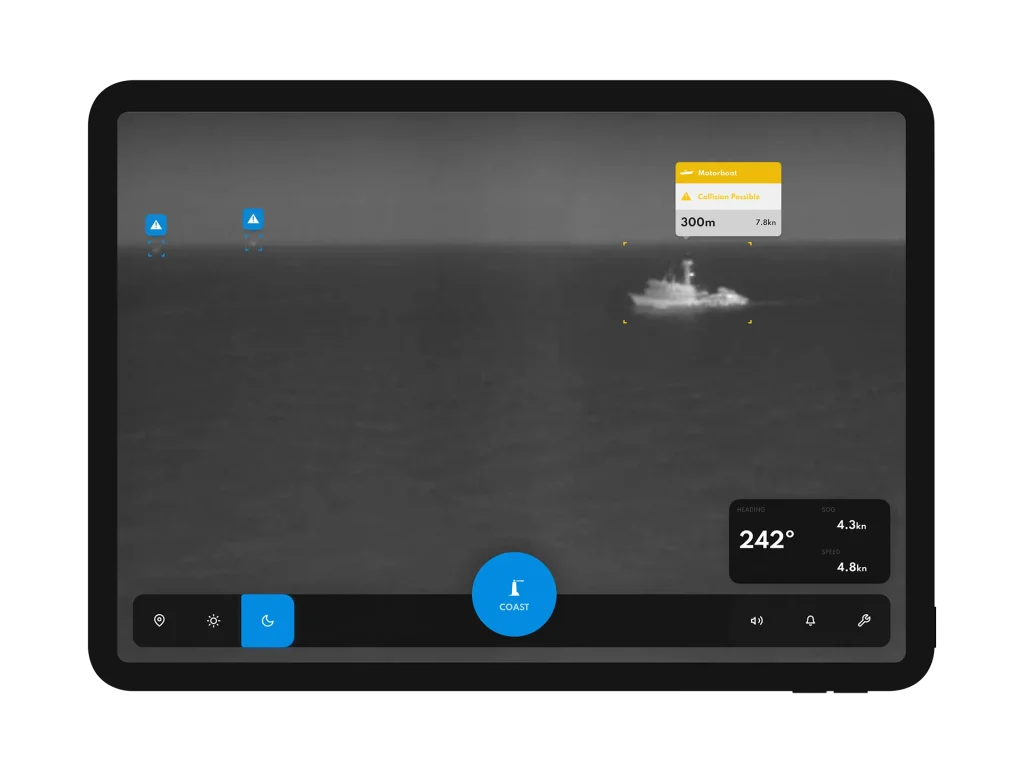Home » Collision Avoidance System on the Route du Rhum
Also true is that a high speed collision with any object on a foil-born yacht may well not only damage the yacht, but injure her skipper too.
It is for this reason that in this year’s Route du Rhum – Destination Guadeloupe single handed offshore race from St Malo to Guadeloupe, SEA.AI has been fitted to 50% of the boats in the Ultim and IMOCA classes plus Philippe Poupon’s FLO.
SEA.AI collision avoidance system fills in a gap in a yacht’s arsenal, alongside radar – which works well for larger objects– and AIS – which identifies suitably equipped vessels. SEA.AI’s speciality is to detect constantly, 24/7, night and day, items in the water that are smaller than those visible to radar, but which might still be capable of severely damaging a boat and injuring her crew. Such objects might be logs, containers, buoys, large marine life, small vessels such as local fishing boats, icebergs etc. On fully crewed vessels, SEA.AI is also highly valuable for use in man overboard incidents, especially at night.
SEA.AI comprises a compact, lightweight vision unit mounted at the masthead and a processing unit located down below. The former carries an array of cameras able to capture optical images during daytime, in high resolution and even in low light, and thermal images 24 hours a day. These images are then fed to the processing unit where the SEA.AI’s algorithm compares the images with its massive and ever-expanding database to determine whether or not something in the water ahead represents a collision threat.
Competitors using SEA.AI collision avoidance system in the Route du Rhum will continue to contribute to this learning process, helping to improve SEA.AI and ultimately making the sea a safer place for all marine users, be they using the sea for pleasure, sport or commercial purposes.
Given how catastrophic a collision between a high speed sailing yacht and something in the water can be, the majority of top teams in the Route du Rhum are all carrying SEA.AI as a further device to ensure that they reach Guadeloupe with both boat and skipper in one piece and free from any collision-induced damage. The race will also provide further valuable data and insight into how best to use the technology.

Vendée Globe skipper Romain Attanasio is a typical SEA.AI user in the IMOCA class. He has used the system on his IMOCA Fortinet–Best Western for three years: “It is always on – like having an extra crew on watch except for the crew it is often hard to be looking ahead constantly as there is so much water. But SEA.AI is up there, always looking ahead. Frankly, I could not do without it. The biggest risk in racing at sea are collisions, so the most important thing is to look ahead. I think, honestly, SEA.AI should be on all boats.”
Attanasio recalls that in the Défi Azimut he avoided two trawlers just 50m away, thanks to SEA.AI’s alarm, having not spotted them on AIS. On the Vendée Globe in Le Maire Strait shortly after passing Cape Horn the same alarm alerted him to the presence of a small sailboat he had not spotted. “There are plenty of times SEA.AI has worked for me. During the day I keep a lookout but at night I rely more on SEA.AI to look as it is rarely wrong.”
As every day goes by and SEA.AI’s database of images continues to be updated, the AI’s ability to detect and identify threats is forever refined and improved. At present the SEA.AI Competition 640 equipment used on racing yachts in the Route du Rhum can accurately identify relatively small items such as a buoy or a person up to 150m ahead. In years to come its cameras will certainly be improved with higher resolution models enabling the range with which SEA.AI can identify objects to be extended. The new, larger and heavier model, the SEA.AI Sentry, designed for commercial ships or motorboats, can already identify similar objects up to 700m ahead.
Already AIS targets can be superimposed over radar displays or fed into routing software, so it seems likely that being able to superimpose threats detected by SEA.AI can be used in a similar way, in the future.
But for future single handed offshore races such as the Route du Rhum and Vendée Globe, there is also the potentially very useful prospect of SEA.AI sending essential information to a yacht’s autopilot. So, in the event of an object being identified ahead and the skipper failing to react to it in time, the autopilot could decide to steer a path around it. A step closer to the automatic emergency braking system well established in the car industry and another milestone on the way to autonomous navigation on the sea.
This Friday (28th April 2024), the Transat CIC will set sail from Lorient in the Western France to New York in the East Coast of the USA. This race will feature 33 IMOCA of which 20 are equipped with SEA.AI Machine Vision System.
SEA.AI demonstrated its machine vision at the Congressional Boating Caucus briefing on April 11, 2024, in Washington, D.C..
Baltic Yachts, a Pioneering Shipyard, integrates SEA.AI Machine Vision Technology to its Range of Innovative Options